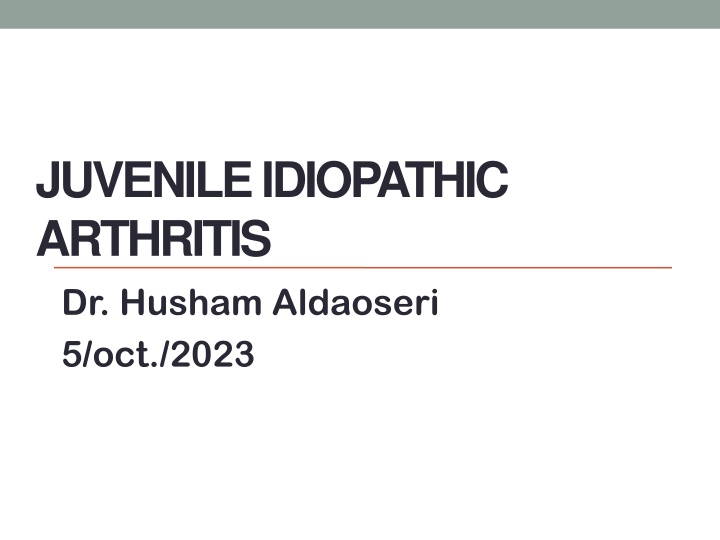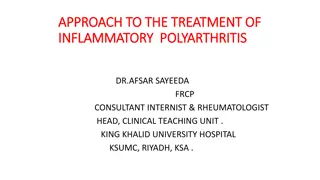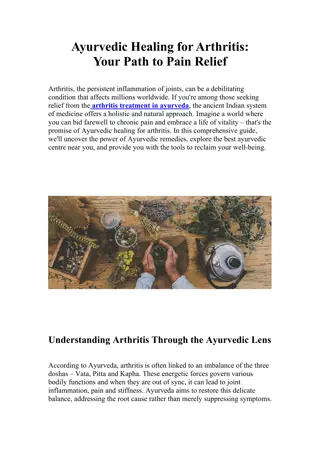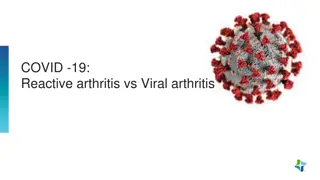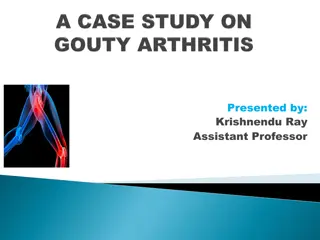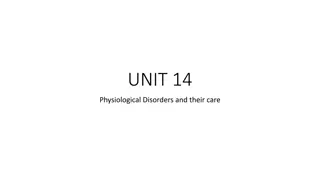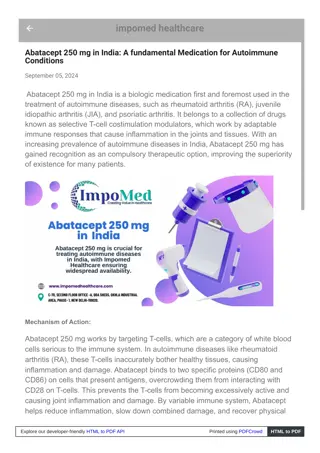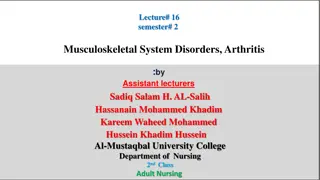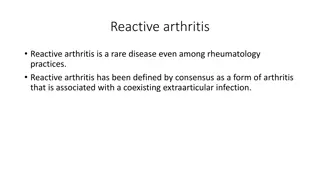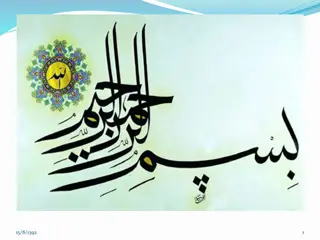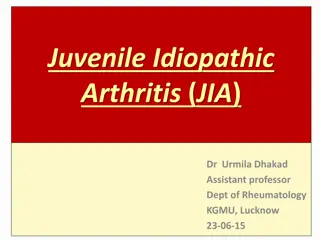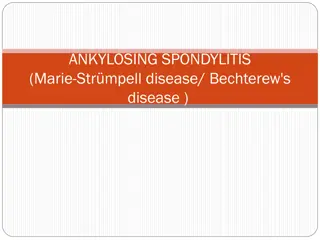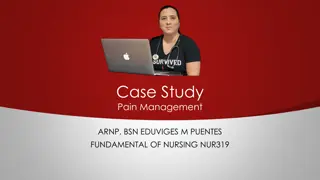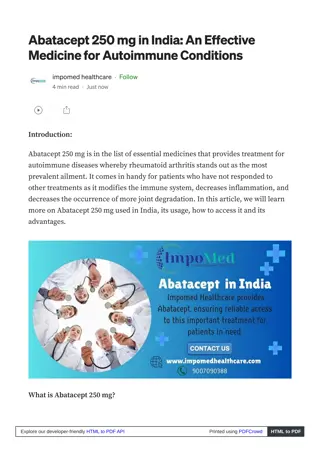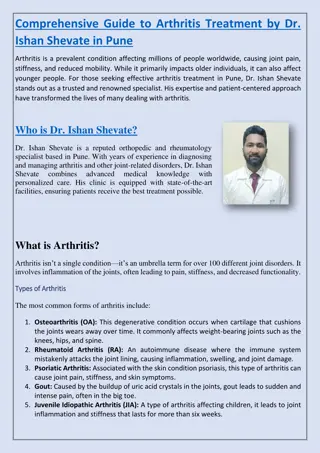ARTHRITIS
Juvenile idiopathic arthritis (JIA) is the most common form of childhood arthritis, characterized by chronic arthritis of unknown cause. It encompasses various categories, including systemic, polyarthritis, oligoarthritis, psoriatic arthritis, and more. Symptoms may include fever, rash, lymphadenopathy, and organ enlargement. Diagnosis criteria involve disease onset before the 16th birthday and persistent arthritis in joints. Treatment aims to manage symptoms and prevent complications through medication, physical therapy, and lifestyle adjustments.
Download Presentation

Please find below an Image/Link to download the presentation.
The content on the website is provided AS IS for your information and personal use only. It may not be sold, licensed, or shared on other websites without obtaining consent from the author.If you encounter any issues during the download, it is possible that the publisher has removed the file from their server.
You are allowed to download the files provided on this website for personal or commercial use, subject to the condition that they are used lawfully. All files are the property of their respective owners.
The content on the website is provided AS IS for your information and personal use only. It may not be sold, licensed, or shared on other websites without obtaining consent from the author.
E N D
Presentation Transcript
JUVENILE IDIOPATHIC ARTHRITIS Dr. Husham Aldaoseri 5/oct./2023
Juvenile idiopathic arthritis (JIA) is the most common form of childhood arthritis and one of the more common chronic childhood illnesses. As the term indicates, the cause is unknown. JIA is an umbrella term that refers to a group of disorders that have in common chronic arthritis. The prevalence of JIA has been estimated to be between 57 and 220 per 100,000 children younger than 16 years
The criteria for JIA require Disease onset before the 16th birthday Persistent objective arthritis in one or more joints for at least 6 weeks Exclusion of other causes of childhood arthritis .
Juvenile idiopathic arthritis is subdivided into the following categories: Systemic Polyarthritis rheumatoid factor positive, polyarthritis RF negative, Oligoarthritis (subcategories of persistent and extended), Psoriatic arthritis, Enthesitis-related arthritis Undifferentiated arthritis .
SYSTEMIC CATEGORY Classification as systemic JIA requires that the child demonstrate daily fever of at least 2 weeks duration that for at least three of those days is documented to be quotidian (defined as a daily recurrent fever that rises to 39 C once a day and returns to 37 C or below between fever spikes) and at least one of the following: A. An evanescent, nonfixed, erythematous rash . B. Generalized lymph node enlargement. C. Hepatomegaly and/or splenomegaly. D. Serositis (pericardial, pleural or peritoneal).
Erythematous & evanescent rash of SOJIA. Frequently, rash is obvious only at height of fever and sometimes confined to axillary region, ant chest wall and inside both thighs.
. Children with sJIA often have growth delay, osteopenia, diffuse lymphadenopathy, hepatosplenomegaly, pericarditis, pleuritis, anemia, leukocytosis, thrombocytosis, and elevated acute-phase reactants. Positive rheumatoid factor (RF) and uveitis are rare. The extra- articular features are usually mild to moderate in severity and almost always self-limited. sJIA patients can develop pericardial tamponade, severe vasculitis with secondary consumptive coagulopathy, and macrophage activation syndrome, all of which require intense steroid therapy.
sJIA patients can develop pericardial tamponade, severe vasculitis with secondary consumptive coagulopathy, and macrophage activation syndrome, all of which require intense steroid therapy.
POLYARTHRITIS R F POSITIVE AND R F NEGATIVE CATEGORIES Arthritis in five or more joints during the first 6 months of the disease. To be considered RF+, the patient must have at least two positive results for RF at least 3 months apart during the first 6 months of disease. poJIA RF+ patients are almost always girls with later disease onset (at least 8 years old) who are usually HLA-DR4 positive
have symmetric small joint arthritis, and are at greater risk for developing erosions, nodules, and poor functional outcome compared with RF patients. poJIA RF+ resembles adult-onset RA more than any other JIA subset.
JIA oligoarthritis arthritis in four or less joints during the first 6 months of the disease. oJIA patients are divided into two subcategories: persistent and extended. Persistent oJIA patients never have a cumulative total of more than four joints with arthritis during the course of the disease . extended oJIA patients demonstrate a cumulative total during the course of the disease of arthritis in five or more joints after the first 6 months of the disease. oJIA is the most frequent of the JIA categories
Persistent oJIA has the best overall articular outcome of all JIA categories. Patients with oJIA are commonly younger (1 5 years old at onset), are more likely to be girls (4 to 1), are often ANA positive, and have the greatest risk for developing chronic eye inflammation . Eye involvement occurs in 30% to 50% of oJIA patients .
JIA, Psoriatic arthritis However, the classic psoriatic rash may not appear for many years after the onset of the arthritis. Only about 10% of children have the onset of the rash and the arthritis at the same time. In the rest of the patients (33% 67%), the rash comes first having psoriatic arthritis if they have arthritis and at least two of the following three criteria: Dactylitis, nail pitting or onycholysis, and psoriasis in a first-degree relative.
ENTHESITIS RELATED Enthesitis refers to inflammation at the insertion of the tendon, ligament, joint capsule, or fascia into the bone. Children are classified as enthesitis juvenile idiopathic arthritis (eJIA) if they have both arthritis and enthesitis.
The most common sites for enthesitis include the superior curve of the patella, infra-patellar at the tibial tuberosity, attachment of the Achilles tendon, attachment of plantar fascia to the calcaneous, and sole of the foot at the metatarsal heads
Laboratory Findings In monoarthritis and mild Persistent Oligo patients, there is often no sign of acute phase response in the serum In the more severe cases and in Extended Oligo patients, the ESR and CRP are raised. Rheumatoid factor is not present, but low titer antinuclear antibodies (ANA) are frequently seen. There are no other autoantibodies. There are no specific laboratory tests for systemic JIA (sJIA), but there are characteristic patterns of laboratory abnormalities.
There is typically a very high level of CRP, high ESR, neutrophilia, thrombocytosis, and a hypochromic, microcytic anemia. Liver enzymes and coagulation screen might be abnormal in the more severe cases and in the complication often seen in severe sJIA, macrophage activation syndrome (MAS).
Rheumatoid factor positive polyarticular JIA is similar to adult-onset rheumatoid arthritis (RA) with severe widespread erosive joint disease. The similarities between juvenile- and adult-onset RA include the presence of rheumatoid factor, as well as other more specialized antibodies, such as anti-cyclic citrullinated peptides (anti-CCP) .
Treatment Nonsteroidal Anti-Inflammatory Drugs Only about 25% to 33% of JIA patients, mainly those with oligoarthritis, respond well to NSAIDs. They are used more to treat pain, stiffness, and the fever associated with systemic arthritis.
Corticosteroids Due to many deleterious effects, especially the effect on bone and growth, the use of systemic corticosteroids for JIA should be minimized. There is no evidence that systemic corticosteroids are disease modifying.
The main indications for systemic use of corticosteroids are uncontrolled fever, serositis, and the macrophage activation syndrome in systemic arthritis. Another indication is use as a bridging medication until other medications become effective. In some patients, periodic intravenous pulses of corticosteroids There is excellent evidence for the efficacy of intra-articular injections of corticosteroids, mainly in patients with oligoarthritis.
Methotrexate The use of methotrexate (MTX) is the cornerstone of the medical management plan for most patients with JIA and polyarthritis . The initial dose is 10 mg/m2/ week given orally or parenterally. If not effective the MTX dose should be increased to 15 mg/m2/week and given parenterally .
Biologic-Modifying Medications Anti-Tumor Necrosis Factor Medications These medications to be highly effective in patients with polyarthritis, including patients who failed MTX. Etanercept less effective in systemic arthritis . Infliximab is more effective than etanercept for JIA-related uveitis.
Interleukin IL1 Receptor Antagonists Initial very promising results using anakinra for systemic arthritis have been reported for both the systemic and articular components, including patients not responsive to anti-TNF medications. Anakinra is less effective for polyarthritis than anti-TNF medications. IL1 antibody Canakinomab. Anti-Interleukin-6 Receptor AntibodyTocilizumab, an anti- IL6 receptor antibody, reported significant improvements in the majority of the patients as soon as after the second dose.
